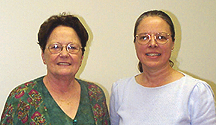
| T H E N I H C A T A L Y S T | S E P T E M B E R – O C T O B E R 2000 |
|
|
|
UNIQUE SUMMER PROGRAM:GENETICS AT THE NIH CLOISTERS |
text and photos
|
 |
|
Partners:
Francine Nichols (left) , the Georgetown University coordinator of the
Summer Genetics Institute partnership forged by NIH's Annette Wysocki
(right). The SGI, Wysocki says, is a fine example of the collaborations
the NIH Graduate Partnership Program has been established to create (see
"Catalytic Reactions").
|
Fourteen students were at the right place at the right time this summer—at the same time the completion of a draft sequence of nearly all of the human genome was announced, these students were navigating between lab and lecture room here, absorbing the message between those sequences, in the first season of the NINR Summer Genetics Institute (SGI).
The program combines complementary lecture and lab sessions targeted to molecular genetics, together with case tutorials to place it all in a clinical context. Field trips (for instance, to the NCI microarray facility and the NHGRI sequencing facility) and a heavy dose of required and supplementary reading, round out the program—eight weeks of immersion in everything from cell biology and modes of inheritance to genetic counseling and family dynamics, including 150 hours of lab work. The institute received three applications for each position; more are anticipated next year, says Annette Wysocki, now of NIDCR and a driving force behind the program when she was NINR scientific director.
The 14 students selected for the pioneer program were all graduate students, faculty, or advanced practice nurses in academic medical settings. Two were nurse researchers, and six were completing their doctoral programs. Each applicant wrote a statement of interest, including how they planned to use the course in their research, practice, and educational activities.
The 12-credit graduate course is approved by Georgetown University (Washington, D.C.) and underwritten by NINR; the students receive IRTA stipends. Credit is not automatic; there are difficult midterm and final exams, and students must also craft a written research proposal in an R01 format. "You can get bits and pieces of this course elsewhere," says Wysocki, "but this is the only course with all of it."
The hope, she said, is
that the course will serve as a model and be re-created and incorporated into
curricula across the country. NINR has already received inquiries about using
materials developed for the program in other university settings. ![]()
Into the Future "Ninety percent of the human genetic sequence in draft form is now sitting on the Internet for all to see–and maybe they’ll help us figure out what it means," Francis Collins, head of the Human Genome Project, quipped to the soon-to-be first graduating class of the NINR Summer Genetics Institute. The precise gene variants contribute to the more common conditions—such as heart disease, diabetes, hypertension, and obesity—are not yet known, Collins said, "but that lies just ahead of us, and I worry: Are there providers out there? Will the information be used inappropriately? We need medical care givers and excellent research in this area, and I am delighted to see this cohort that is serious about genetics in nursing. Especially the way managed care has placed constraints on physicians, I think a lot of genetics will be practiced by nurses." Collins described
a collaboration between U.S. and Finnish investigators to track genes
that confer a risk for type 2 diabetes—a paradigm of non-Mendelian
genetics. Five thousand samples from more than 1,000 families, each with
at least two affected siblings, now sit in Building 9 freezers, Collins
said. "We scanned the genome and found four broad and blurry regions
with, we think, contributing genes that we hope to zero in on in the next
year or two." Similar scenarios can be expected for other conditions,
he said. |
Marcia Phillips has been a clinical nurse for 20 years—"everything from the neonatal unit to the emergency room to research"—and is now working on her doctoral dissertation on breast cancer genetics. This program, she said, of the Summer Genetics Institute, was "much more scientific at the molecular level [than any she’d experienced], and it gave me a much better understanding of the disease process. It opened up a new world" that will be passed along to her patients. There was also considerably more lab work than she’d ever been exposed to. "I didn’t know what a pipette was, and now I’ve run Southern blots, done PCR, separated the DNA to determine which cells have mutations." Perhaps five nursing schools in the country have programs in genetics, she said, and none that she knows of compares with this one. On the last day
of classes, after hearing a two-hour lecture by Frank
Castora of the Eastern Virginia Medical School in Norfolk (pictured
above) on the mechanisms of mitochondrial genetics, Phillips and her classmates
repaired to the lab downstairs, where they learned from Castora the hands-on
mechanics of the "detection of mutation by single-strand conformational
polymorphism."
|